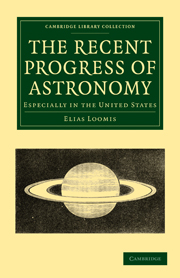Book contents
- Frontmatter
- PREFACE
- Contents
- CHAPTER I RECENT ADDITIONS TO OUR KNOWLEDGE OF THE PLANETARY SYSTEM
- CHAPTER II RECENT ADDITIONS TO OUR KNOWLEDGE OF COMETS
- CHAPTER III ADDITIONS TO OUR KNOWLEDGE OF FIXED STARS AND NEBULÆ
- CHAPTER IV PROGRESS OF ASTRONOMY IN THE UNITED STATES
- SECTION I
- SECTION II
- SECTION III
- SECTION IV
- SECTION V
- SECTION VI
- POSTSCRIPT
- Frontmatter
- PREFACE
- Contents
- CHAPTER I RECENT ADDITIONS TO OUR KNOWLEDGE OF THE PLANETARY SYSTEM
- CHAPTER II RECENT ADDITIONS TO OUR KNOWLEDGE OF COMETS
- CHAPTER III ADDITIONS TO OUR KNOWLEDGE OF FIXED STARS AND NEBULÆ
- CHAPTER IV PROGRESS OF ASTRONOMY IN THE UNITED STATES
- SECTION I
- SECTION II
- SECTION III
- SECTION IV
- SECTION V
- SECTION VI
- POSTSCRIPT
Summary
It is but a few years since practical astronomy began to be cultivated in the United States in an efficient and systematic manner. Until recently, the instruments in our possession were but few and small, and the observations which were made, seldom extended beyond the notice of the time of a solar or lunar eclipse, or the measurement of a comet's distance from neighboring stars with a sextant.
The most important astronomical enterprise undertaken in this country, during the last century, was the observation of the transit of Venus in June, 1769. Upon the observations of this transit depended the more accurate determination of the sun's parallax; from which is deduced the distance of the earth from the sun, and thence the absolute distances of all the planets. Only three transits of Venus are known to have ever been seeń by any human being. The first occurred in December, 1639, and was seen by but one individual, named Horrocks, who lived near Liverpool, England. The next transit occurred in June, 1761, and was carefnlly observed in different parts of the world, and important conclusions were drawn from it as to the sun's parallax. It was known, however, that its next recurrence, which was to take place in 1769, would be under more favorable circumstances, and several of the governments of Europe sent astronomers to various parts of the globe favorably situated for the observations. France sent an astronomer to California, England sent astronomers to Hudson's Bay, to Madras, and to the Island of Otaheite, in the South Sea. Several Russian observers were stationed at various points of Siberia and the Russian empire.
- Type
- Chapter
- Information
- The Recent Progress of AstronomyEspecially in the United States, pp. 202 - 292Publisher: Cambridge University PressPrint publication year: 2010First published in: 1856

